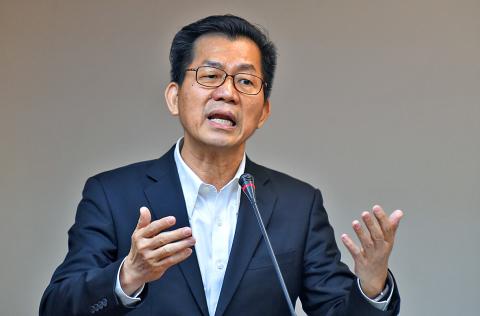The government does not have regulations to prohibit Asia Cement Corp (亞洲水泥) from mining in Hualien County, including its 25 hectares of quarry within the boundaries of Taroko National Park, the Ministry of Economic Affairs (MOEA) said yesterday.
The ministry’s remarks came after Environmental Protection Administration Minister Lee Ying-yuan (李應元) on Wednesday said the company would have to end its operations in Taroko National Park next year when its license for that quarry expires.
Lee said the move would be part of his agency’s efforts to ban mining in national parks.

Photo: Liu Hsin-de, Taipei Times
The government in 1977 granted Asia Cement, Taiwan’s second-largest cement maker, a 20-year license to mine in 442.7 hectares in the county as part of plans to develop eastern Taiwan in the 1970s, Bureau of Mines Director-General Chu Ming-chau (朱明昭) yesterday told a news conference in Taipei.
Taroko National Park was established in 1986, and 25 hectares of the park overlapped with Asia Cement’s quarry, Chu said.
Although the government allowed Asia Cement to continue mining on the 25 hectares, the company inked a memorandum with the park administration that it would not extend its operations after its mining license expires on Nov. 22 next year, Chu said.
“Actually, Asia Cement stopped mining in the park a while ago… It is now helping the park restore the environment of the 25 hectares,” Chu said.
Given that Asia Cement’s operational and production efficiency in Hualien follows ministry standards, and a mining license extension does not require another environmental impact assessment, there would be no reason for the ministry to reject an application by the company to extend its mining license on the land outside of the park.
“Unless the EPA asks the economics ministry to expand the area of the no-mining zone around Taroko National Park, and in that case we would need to review the feasibility,” Chu added in a telephone interview.
However, if the government really wants to stop Asia Cement from operating outside of the park, it is going to have to compensate the company for any potential losses, Chu said, adding such a move would impact the firm’s downstream suppliers in eastern Taiwan and more than 1,000 employees, he said.
EPA officials are to discuss more details of the agency’s plans with the ministry soon, Chu said.

TRAGEDY STRIKES TAIPEI: The suspect died after falling off a building after he threw smoke grenades into Taipei Main Station and went on a killing spree in Zhongshan A 27-year-old suspect allegedly threw smoke grenades in Taipei Main Station and then proceeded to Zhongshan MRT Station in a random killing spree that resulted in the death of the suspect and two other civilians, and seven injured, including one in critical condition, as of press time last night. The suspect, identified as a man surnamed Chang Wen (張文), allegedly began the attack at Taipei Main Station, the Taipei Fire Department said, adding that it received a report at 5:24pm that smoke grenades had been thrown in the station. One man in his 50s was rushed to hospital after a cardiac arrest

SAFETY FIRST: Double the number of police were deployed at the Taipei Marathon, while other cities released plans to bolster public event safety Authorities across Taiwan have stepped up security measures ahead of Christmas and New Year events, following a knife and smoke bomb attack in Taipei on Friday that left four people dead and 11 injured. In a bid to prevent potential copycat incidents, police deployments have been expanded for large gatherings, transport hubs, and other crowded public spaces, according to official statements from police and city authorities. Taipei Mayor Chiang Wan-an (蔣萬安) said the city has “comprehensively raised security readiness” in crowded areas, increased police deployments with armed officers, and intensified patrols during weekends and nighttime hours. For large-scale events, security checkpoints and explosives

A car bomb killed a senior Russian general in southern Moscow yesterday morning, the latest high-profile army figure to be blown up in a blast that came just hours after Russian and Ukrainian delegates held separate talks in Miami on a plan to end the war. Kyiv has not commented on the incident, but Russian investigators said they were probing whether the blast was “linked” to “Ukrainian special forces.” The attack was similar to other assassinations of generals and pro-war figures that have either been claimed, or are widely believed to have been orchestrated, by Ukraine. Russian Lieutenant General Fanil Sarvarov, 56, head

PUBLIC SAFETY: The premier said that security would be tightened in transport hubs, while President Lai commended the public for their bravery The government is to deploy more police, including rapid response units, in crowded public areas to ensure a swift response to any threats, President William Lai (賴清德) said yesterday after a knife attack killed three people and injured 11 in Taipei the previous day. Lai made the remarks following a briefing by the National Police Agency on the progress of the investigation, saying that the attack underscored the importance of cooperation in public security between the central and local governments. The attack unfolded in the early evening on Friday around Taipei Main Station’s M7 exit and later near the Taipei MRT’s Zhongshan